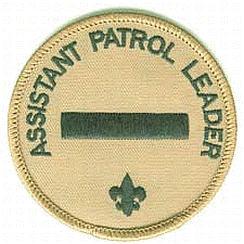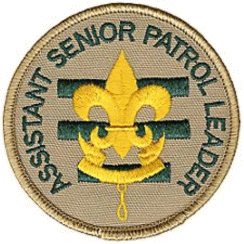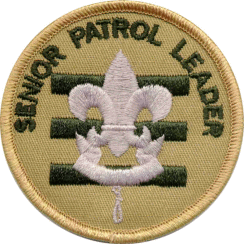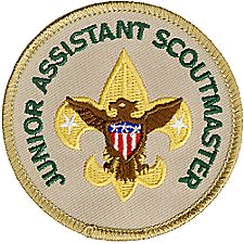
Troop Leadership Requirements
Troop Leadership Position requirements
Senior Patrol Leader – MUST BE A STAR RANK OR HIGHER MUST HAVE BEEN ONE OR MORE OF THE FOLLOWING….
Den Chief, or Patrol Leader, Troop Guide, or Assistant Senior Patrol Leader
NEEDS TO HAVE TAKEN…
Troop Training
NYLT Preferred
Asst. Senior Patrol Leader – MUST BE A STAR RANK OR HIGHER MUST HAVE BEEN ONE OR MORE OF THE FOLLOWING….
Den Chief, Patrol Leader, or Troop Guide
NEEDS TO HAVE TAKEN…
Troop Training
NYLT Preferred
Troop Guide – MUST BE STAR RANK OR HIGHER MUST HAVE BEEN ONE OR MORE OF THE FOLLOWING….
Den Chief, or Patrol Leader, Asst. Patrol Leader, Senior Patrol leader, or Asst. Senior Patrol leader
NEEDS TO HAVE TAKEN…
Troop Training
NYLT Preferred
Scoutmaster needs to approve!!
Junior Asst. Scoutmaster – MUST BE AN EAGLE SCOUT MUST HAVE BEEN ONE OR MORE OF THE FOLLOWING….
Den Chief, Asst. Patrol Leader, Patrol Leader, Asst. Senior Patrol leader, or Senior Patrol leader
NEEDS TO HAVE TAKEN…
Troop Training & NYLT
NEEDS SCOUTMASTER & COMMITTEE APPROVEAL!!
NOTE: IF AN EAGLE SCOUT DOESN’T TAKE NYLT THEN THE HIGHEST LEADERSHIP POSITION THEY CAN HOLD WOULD BE A NON-ELECTED ONE LIKE TROOP GUIDE, BUT ONLY IF THEY ARE APRROVED BY THE SCOUTMASTER AND COMMITTEE!!
Elections Requirements
-
All speeches are to be done the same day of the elections.
-
NO Speeches are to exceed more than 5 minutes.

Den Chief General Information
Position: Appointed by the Scoutmaster
Term: Minimum of 1 full year (to be eligible for the Den Chief Service Award)
Reports to: Assistant Scoutmasters / JASM, Den Leader & Cubmaster
Role: Den Chiefs work with Cub Scouts, Webelos Scouts, Den Leaders, and Cubmasters in Cub Scout Packs.
Comments: The Den Chief provides knowledge of games and Scout skills that many Den Leaders lack. The Den Chief is also a recruiter for the Troop. This function is important because no Troop can thrive without new members and most will come from Cub Scouting.
QUALIFICATIONS
Age: 12 or older
Rank: 1st Class Rank or higher
Experience: none
Attendance: Goal of 80% over previous 6 months
PERFORMANCE REQUIREMENTS
Training: You must attend the Troop Leadership Training even if you have attended in the past. Den Chief training is required for the Den Chief Service Award.
Attendance: You are expected to attend 80% of all Troop meetings, outings, service projects. In terms of attendance with your Den, you are expected to attend 80% of Den meetings and Pack functions. You must inform the Den Leader if you will be absent. If your attendance is low, or if you have three (3) unexcused absences in a row, you will be removed from office.
Effort: When you accept this position, you agree to provide service and leadership to the Den and Pack. You are expected to give this job your best effort.
GENERAL LEADERSHIP RESPONSIBILITIES
Uniform: Set a good example by wearing your uniform correctly. Wear all of the parts of the Troop uniform, shirt tucked in, with all required badges in their correct locations.
Behavior: Set a good example by living the Scout Oath and Law in your everyday life. Show Scout Spirit in everything you say and do.
Attendance: Set a good example by being an active Scout. Be on time for meetings and activities. You must call the Den Leader if you are not going to be at a Den or Pack meeting or if you have to miss an activity.
SPECIFIC LEADERSHIP RESPONSIBILITIES
-
Set a good example for Scouts to follow (always wear your uniform properly to meetings).
-
Enthusiastically wears the Scout uniform correctly
-
Receive Den Chief Training / know the purposes of Cub Scouting.
-
Be a friend to the boys in the Den.
-
Help Cub Scouts achieve the purposes of Scouting.
-
Encourage Cub Scouts to join a Boy Scout Troop upon graduation.
-
Serves as ambassador to the Troop and actively recruits new scouts from the Pack.
-
Help at weekly Den meetings and monthly Pack meetings.
-
Assist with Den meeting activities.
-
Meet with adult members of the Den, Pack, and Troop as necessary to discuss your role and responsibilities to the Den and Pack.
-
Lives the Scout Oath and Law
-
Shows Scout Spirit

Troop Guide General Information
Position: Appointed by the Scoutmaster and Committee
Term: 1 year terms from appointment until age 18
Reports to: Junior Assistant Scoutmaster and Scoutmaster
Role: The Troop Guide works with the youth leadership within the Troop.
Comments: The Troop Guide has already held many leadership positions, and is thereby a valuable asset to help guide and assist the newly appointed youth leaders that are currently running the Troop as they work through their own leadership difficulties.
QUALIFICATIONS
Age: 13 or older
Rank: STAR or Higher
Experience: Previous leadership position as Den Chief, Patrol Leader, Assistant Senior Patrol Leader, Senior Patrol Leader, or Instructor
Attendance: Goal of 80% over previous 6 months
PERFORMANCE REQUIREMENTS
Training: You must attend the Troop Leader Training even if you have attended in the past. Completion of National Youth Leadership Training (NYLT) is strongly recommended.
Attendance: You are expected to attend 80% of all troop meetings, Patrol Leaders' Council meetings, outings, and service projects. If your attendance is low, or if you have three (3) unexcused absences in a row, you will be removed from office.
Effort: You are expected to give this job your best effort.
GENERAL LEADERSHIP RESPONSIBILITIES
Uniform: Set the example by wearing your uniform correctly. This means that you will wear all of the parts of the troop uniform, shirttail tucked in, with all required badges in their correct locations.
Behavior: Set the example by living the Scout Oath and Law in your everyday life. Show Scout Spirit in everything you say and do.
Attendance: Set the example by being an active Scout. Be on-time for meetings and activities. You must call the Scoutmaster if you are not going to be at a meeting or if you suddenly have to miss an outing.
SPECIFIC LEADERSHIP RESPONSIBILITIES
-
Introduces new Scouts to troop operations.
-
Enthusiastically wears the Scout uniform correctly
-
Guides new Scouts through early Scouting activities
-
Shields new Scouts from harassment by older Scouts.
-
Helps new Scouts earn First Class in their first year.
-
Teaches basic Scout skills.
-
Closely monitors Scout advancement.
-
Coaches the Patrol Leader of new Scouts on his duties.
-
Works with the Patrol Leaders at Patrol Leaders' Council meetings.
-
Attends Patrol Leader Council meetings.
-
Assists the Assistant Scoutmasters with training.
-
Counsels individual Scouts on Scouting challenges.
-
Lives the Scout Oath and Law
-
Shows Scout Spirit

Assistant Patrol Leader General Information
Position: Appointed by the Patrol Leader.
Term: 1 year
Reports to: Patrol Leader, Senior Patrol Leader, Junior Assistant Scoutmaster and Scoutmaster
Role: The Assistant Patrol Leader is appointed by the Patrol Leader and leads the patrol in his absence.
Comments: Substituting for the Patrol Leader is only part of the Assistant Patrol Leader's job. The APL actively helps run the patrol.
Note: The Assistant Patrol Leader position does not satisfy the Life Rank requirement for a position of responsibility in the Troop.
QUALIFICATIONS
Age: None
Rank: 2nd Class or higher
Experience: None
Attendance: Goal of 80% of Troop meetings and activities
PERFORMANCE REQUIREMENTS
Training: You must attend the Troop Leadership Training even if you have attended in the past.
Attendance: You are expected to attend 80% of all Troop meetings, Patrol Leader Council meetings if asked to by your Patrol Leader, outings, and service
projects. If your attendance is low, or if you have three (3) unexcused absences in a row, you will be removed from office.
Effort: You are expected to give this job your best effort.
GENERAL LEADERSHIP RESPONSIBILITIES
Uniform: Set the example by wearing your uniform correctly. Wear all of the parts of the Troop uniform, shirt tucked in, with all required badges in their
correct locations.
Behavior: Set the example by living the Scout Oath, Law and Outdoor Code in your everyday life. Show Scout Spirit in everything you say and do.
Attendance: Set a good example by being an active Scout. Be on time for meetings and activities. You must call the Patrol Leader or Senior Patrol Leader if you
are not going to be at a meeting or if you have to miss an outing. You also need to make sure that someone will assume your responsibilities when
you are going to be absent.
SPECIFIC LEADERSHIP RESPONSIBILITIES
-
Set a GOOD EXAMPLE (the most powerful form of leadership).
-
Help the Patrol Leader plan and lead patrol meetings and activities.
-
Help the Patrol Leader keep patrol members informed.
-
Help the patrol get ready for all Troop activities.
-
Represent patrol at PLC meetings when the Patrol Leader cannot attend.
-
Always lend a hand running the Patrol and building Patrol spirit.
This is not considered a “Position of Leadership” but will give the Scout experience to hold a “Position of Leadership”. The APL does NOT have a vote in the PLC.

Patrol Leader General Information
Position: Appointed by the Senior Patrol Leader.
Term: 1 year
Reports to: Senior Patrol Leader, Junior Assistant Scoutmaster and Scoutmaster
Role Leads patrol level activities, and represents his patrol on the Patrol Leaders Council.
Comments: The Patrol Leader has a very important job in the Troop. He has the closest contact with the patrol members and is in the perfect position to help them along the scouting trail. Patrol Leaders also serve on the Patrol Leaders Council (PLC), and represent their patrol in planning the Troop program.
QUALIFICATIONS:
Age: 12 or older
Rank: 1st Class Rank or higher
Experience: Den Chief, Assistant Patrol Leader
Attendance: Goal of 80% of Troop meetings and activities
PERFORMANCE REQUIREMENTS
Training: You must attend Troop Leadership Training even if you have attended in the past.
Attendance: You are expected to attend 80% of all Troop meetings, Patrol Leaders Council meetings, outings, and service projects. If your attendance is low,
or if you have three (3) unexcused absences in a row, you will be removed from office.
Effort: When you accept this position, you agree to provide service and leadership to the Troop. You are expected to devote lots of time and energy to this job
and give it your best effort.
GENERAL LEADERSHIP RESPONSIBILITIES
Uniform: Set the example by wearing your uniform correctly. Wear all of the parts of the Troop uniform, shirt tucked in, with all required badges in their
correct locations.
Behavior: Set the example by living the Scout Oath, Law and Outdoor Code in your everyday life. Show Scout Spirit in everything you say and do.
Attendance: Set the example by being an active Scout. Be on time for meetings and activities. You must call the Senior Patrol Leader if you are not going to be
at a meeting or if you have to miss an outing. You also must make sure that the Assistant Patrol Leader is ready and able to assume your
responsibilities when you are absent.
SPECIFIC LEADERSHIP RESPONSIBILITIES
-
Set a GOOD EXAMPLE (the most powerful form of leadership) for patrol members to follow.
-
Enthusiastically wears the Scout uniform correctly
-
Help Patrol members advance in rank through First Class, either by teaching the required skills or by setting up situations for meeting the requirements.
-
Know what your patrol members can do.
-
Represent the patrol on the Patrol Leaders Council; report back to the Patrol on the Patrol’s responsibilities for Troop meetings and outings.
-
Plan and lead patrol meetings and patrol activities, especially camping preparations.
-
Assign duties and tasks to patrol members, and follow-up to be sure the job is done right.
-
Keep patrol members informed (weekly telephone/email reminders of upcoming activities).
-
Appoint an Assistant Patrol Leader who can run the patrol in your absence.
-
Train your Assistant Patrol Leader so he is ready to be the next Patrol Leader after you.
-
Help new Scouts learn about Scouting and belong to the Patrol and Troop.
-
Lives the Scout Oath and Law
-
Shows Scout Spirit

Assistant Senior Patrol Leader General Information
Position: Appointed by the Senior Patrol Leader and Scoutmaster.
Term: 1 year (Maximum of two terms serviced)
Reports to: Senior Patrol Leader, Scoutmaster / Asst. Scoutmasters & JASM
Role: When called upon, or if the SPL is absent then the Assistant Senior Patrol Leader is acting Senior Patrol Leader. He also supervises the Troop Scribe, Quartermaster, Librarian, Historian, and Chaplin Aide.
Comments: The most important part of the ASPL position is his work with the other youth leaders. The
ASPL should be familiar with the other positions and stay current with the work being done.
QUALIFICATIONS
Age: 14 or older
Rank: Star or higher
Experience: Previous service as Den Chief, Asst. Patrol Leader, Patrol Leader, or Troop Guide
Attendance: Goal of 80% of Troop meetings and activities over previous 6 months
PERFORMANCE REQUIREMENTS
Training: You must attend the Troop Leader Training even if you have attended in the past. Completion of National Youth Leadership Training (NYLT) is strongly recommended.
Attendance: You are expected to attend 80% of all troop meetings, Patrol Leaders Council meetings, outings, and service projects. If your attendance is low, or if you have three (3) unexcused absences in a row, you will be removed from office.
Effort: When you accept this position, you agree to provide service and leadership to the Troop. You are expected to devote substantial time and energy to this job and give it your best effort.
GENERAL LEADERSHIP RESPONSIBILITIES
Uniform: Set the example by wearing your uniform correctly. This means that you will wear all of the parts of the troop uniform, shirt tucked in, with all required badges in their correct locations.
Behavior: Set the example by living the Scout Oath, Law and Outdoor Code in your everyday life. Show Scout Spirit in everything you say and do.
Attendance: Set the example by being an active Scout. Be on time for meetings and activities. You must call the Senior Patrol Leader or Scoutmaster if you are not going to be at a meeting or if you suddenly have to miss an outing. You also need to make sure that someone will assume your responsibilities.
SPECIFIC LEADERSHIP RESPONSIBILITIES
-
Set a GOOD EXAMPLE (the most powerful form of leadership).
-
Enthusiastically wears the Scout uniform correctly
-
Helps the Senior Patrol Leader lead meetings and activities.
-
Runs the troop and Patrol Leaders Council in the absence of the Senior Patrol Leader.
-
Helps train and supervise the Scribe, Quartermaster, Instructor, Librarian, Historian, and Chaplin Aide.
-
Serves as a member of the Patrol Leader's Council.
-
Lives the Scout Oath and Law
-
Shows Scout Spirit

Senior Patrol Leader General Information
Position: Elected by youth members in the troop.
Term: 1 year (Maximum of two terms serviced)
Reports to: Scoutmaster / Asst. Scoutmaster & JASM
Role: The Senior Patrol Leader represents and leads the Scouts as their top elected youth leader in the Troop.
Comments: The Senior Patrol Leader is the focal point of the Troop. He needs to participate in as many of all Troop functions as possible. A major part of the SPL's job is to manage other Scouts that hold Troop leadership positions. He must be willing and able to provide leadership to everyone, not just his friends or other popular Scouts. The SPL needs to have good leadership skills and be someone who Scouts will wish to follow. One of the major parts of the SPL's job is to appoint other troop leaders. He must choose leaders who are able, not just his friends or other popular Scouts.
QUALIFICATIONS
Age: 14 or older
Rank: Star or Higher
Experience: Previous leadership position as Den Chief, Patrol Leader, Troop Guide, or Assistant Senior Patrol Leader
Attendance: 80% of Troop meetings and activities over previous 6 months
PERFORMANCE REQUIREMENTS
Training: You must attend the Troop Leader Training even if you have attended in the past. Completion of National Youth Leadership Training (NYLT) is strongly recommended.
Attendance: To receive credit for this position, you must have an average attendance record of at least 80% of all troop meetings, Patrol Leaders' Council meetings, outings, and service projects while holding this position. If your attendance is low, or if you have three (3) unexcused absences in a row, you will be removed from office.
Effort: A good senior patrol leader is organized, responsible, experienced, and an active member in the troop. You are expected to devote substantial time and energy to this job and give it your best effort.
GENERAL LEADERSHIP RESPONSIBILITIES
Uniform: Set the example by wearing your uniform correctly. This means that you will wear all of the parts of the troop uniform, shirttail tucked in, with all required badges in their correct locations.
Behavior: Set the example by living the Scout Oath, Law and Outdoor Code in your everyday life. Show Scout Spirit in everything you say and do.
Attendance: Set the example by being an active Scout. Be on time for meetings and activities. You must call the Scoutmaster if you are not going to be at a meeting or if you have to miss an activity or outing. You also need to make sure that someone will assume your responsibilities. You also must train your Assistant Senior Patrol Leader(s) so they are ready to assume your responsibilities in your absence, or when you move on.
SPECIFIC LEADERSHIP RESPONSIBILITIES
-
Set a GOOD EXAMPLE (the most powerful form of leadership).
-
Lead all Troop meetings, events, activities, and Camping preparations.
-
Plan and run Patrol Leaders Council (PLC) meetings.
-
Appoints other troop junior leaders with advice and counsel of the scoutmaster
-
Lead the development of the annual Troop Calendar (meetings, outings)
-
Lead the planning of Troop meetings (presentations, skill instruction, competitions, etc.)
-
Select and administer disciplinary action, when necessary
-
Assign duties and responsibilities to PLC members.
-
Mentor Patrol Leaders and other Troop leaders (especially future SPL candidates).
-
Assist the Scoutmaster with leadership training for the Patrol Leaders Council

Instructor General Information
Position: Appointed by the Scoutmaster & Committee
Term: 1 year terms from appointment until age 18
Reports to: Junior Assistant Scoutmaster and Scoutmaster
Role: Instructors teach and test scouting skills
Comments: Instructors work with Scouts below the 1st Class Rank. Instructors must be knowledgeable and able to teach the scouting skills needed for
Tenderfoot, Second Class, and First Class ranks. Instructors work closely with both the Troop Guides and Patrol Leaders, and though often assigned to one particular patrol, their duties are Troop wide. They should strive to help new Scouts feel comfortable and earn their First Class rank within their first year of scouting.
QUALIFICATIONS
Age: 13 years old
Rank: Star or higher
Experience: Previous leadership position as Den Chief, Patrol Leader, Assistant Senior Patrol Leader, or Senior Patrol Leader, Troop Guide
Attendance: Goal of 80% over the previous 6 months
PERFORMANCE REQUIREMENTS
Training: You must attend the Troop Leadership Training even if you have attended in the past. Completion of National Youth Leadership Training (NYLT) is strongly recommended.
Attendance: You are expected to attend 80% of all Troop meetings, outings, and service projects. If your attendance is low, or if you have three (3) unexcused absences in a row, you will be removed from office.
Effort: When you accept this position, you agree to provide service and leadership to the Troop. You are expected to give this job your best effort.
GENERAL LEADERSHIP RESPONSIBILITIES
Uniform: Set a good example by wearing your uniform correctly. Wear all of the parts of the Troop uniform, shirt tucked in, with all required badges in their correct locations.
Behavior: Set a good example by living the Scout Oath and Law in your everyday life. Show Scout Spirit in everything you say and do.
Attendance: Set a good example by being an active Scout. Be on time for meetings and activities. You must call the Scoutmaster if you are not going to be at a meeting or if you have to miss an outing. You also need to make sure that someone else is ready and will assume your responsibilities when you are going to be absent.
SPECIFIC LEADERSHIP RESPONSIBILITIES
-
Set a GOOD EXAMPLE (the most powerful form of leadership).
-
Enthusiastically wears the Scout uniform correctly
-
Instruct New Scouts in wood tools safety and fire safety within their first month in the Troop.
-
Teaches basic Scouting skills in troop and patrols
-
Run Advancement Sessions to help Scouts reach Tenderfoot, 2nd, and 1st Class ranks.
-
Help the PLC plan meeting programs, arrange for whatever materials may be needed.
-
Work with the Troop Guides and Patrol Leaders to set up learning situations for the Scouts to work on developing skills and advancement. Recruit additional help as needed.
-
When the Troop is working on a merit badge together, arrange for additional support as needed. With the assistance of the Assistant Scoutmasters, recruit merit badge counselors if unavailable within the Troop.
-
Lives the Scout Oath and Law
-
Shows Scout Spirit

Junior Assistant ScoutMaster General Information
Note: IF AN EAGLE SCOUT DOESN’T TAKE NYLT THEN THE HIGHEST LEADERSHIP POSITION THEY CAN HOLD WOULD BE A NON-ELECTED ONE LIKE TROOP GUIDE, BUT ONLY IF THEY ARE APRROVED BY THE SCOUTMASTER AND COMMITTEE!!
Position: Appointed by the Scoutmaster & Committee
Term: From appointment until age 18
Reports to: Scoutmaster
Role: The Junior Assistant Scoutmaster serves in the capacity of an Assistant Scoutmaster except where legal age and maturity are required. He must be at least 16 years old and not yet 18. The Scoutmaster appoints him because of his leadership ability.
Comments: In many cases the JASM has the same responsibilities as an Assistant Scoutmaster.
QUALIFICATIONS
Age: 16 years old
Rank: Eagle
Experience: Den Chief, or Patrol Leader, Troop Guide, Asst. Senior Patrol leader, or Senior Patrol leader
Attendance: Goal of 80% over the previous 6 months
PERFORMANCE REQUIREMENTS
Training: You must attend the Troop Leader Training even if you have attended in the past. Completion of National Youth Leadership Training (NYLT) is REQUIRED.
Attendance: You are expected to attend 80% of all troop meetings, outings, and service projects
Effort: You are expected to give this job your best effort.
GENERAL LEADERSHIP RESPONSIBILITIES
Uniform: Set the example by wearing your uniform correctly. This means that you will wear all of the parts of the troop uniform, shirttail tucked in, with all required badges in their correct locations.
Behavior: Set the example by living the Scout Oath and Law in your everyday life. Show Scout Spirit in everything you say and do.
Attendance: Set the example by being an active Scout. Be on-time for meetings and activities. You must call the Scoutmaster if you are not going to be at a meeting or if you suddenly have to miss an outing. You also need to make sure that someone will assume your responsibilities.
SPECIFIC LEADERSHIP RESPONSIBILITIES
-
Functions as an Assistant Scoutmaster.
-
Performs duties as assigned by the Scoutmaster.
-
Oversees the Troop Guides, Den Chiefs, Troop Instructors and new scout patrol.
